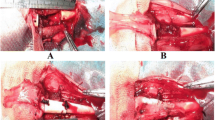Summary
Comparison is made between the survival of two groups of autogenous onlay bone grafts with periosteum taken from the ilium and applied to the nasal bones, in rabbits. In one group the periosteum on the graft surface was left undisturbed, while in the other an overlay of free periosteum was applied to the de-periostealised bone graft at the recipient site.
Using serial radiographic recording of the bone grafts for periods up to one year, together with terminal histological examination, it was found that the “overlay” group survived better at all stages. This is attributed to increased rapidity of vascularisation and osteogenic activity in the periosteal osteoblasts in those grafts having a superimposed free graft of periosteum, with increased production of periosteal new bone more rapidly replacing the underlying bone of the graft.
It is suggested that clinical application of these findings might allow accurate contour sculpturing of onlay bone grafts, while in no way impairing graft survival.
Similar content being viewed by others
References
Albee, F.H.: Bone graft surgery in disease, injury and deformity. New York: Appleton 1940
Axhausen, G.: Arbeiten aus dem Gebiet der Knochenpathologie und Knochenchirurgie. Langenbecks Arch. klin. Chir. 94, 241 (1911)
Duhamel, H.L.: Sur le développement et la crue des os des animaux. Mem. Acad. Sci. 55, 354 (1742)
Engdahl, E.: Bone regeneration in maxillary defects. An experimental investigation on the significance of the periosteum and various media (blood, Surgicel, bone marrow and bone grafts) on bone formation and maxillary growth. Scand. J. plast. reconstr. Surg. Suppl. 8 (1972)
Enneking, W.F.: Histological investigation of bone transplants in immunologically prepared animals. J. Bone Jt Surg. A 39, 597 (1957)
Flourens, P.: Theoric Expérimentale de la Formation des Os. Paris. Bailiiere 1847
Klinkerfuss, G.H.: Study of growing power of periosteal callus when transplanted to costal cartilages. Surg. Gynec. Obstet. 38, 625 (1924)
Knize, D.M.: The influence of periosteum and Calcitonin on onlay bone graft survival. A roentgenographic study. Plast. reconstr. Surg. 53, 190 (1974)
Leriche, R., Policard, A.: The normal and pathological physiology of bone. London: Kimpton 1928
Macewen, W.: The growth of bone. Observations on osteogenesis. The experimental inquiry into the development and reproduction of diaphyseal bone. Glasgow: Maclehose and Sons 1912
McWilliams, C.A.: The function of the periosteum in bone transplants, based on 4 human transplantations without periosteum and some animal experiments. Surg. Gynec. Obstet. 18, 159 (1914)
Ollier, L.: Traité Experimental et Clinique de la Régénération des Os et de la Production Artificielle du Tissu Osseux. Paris: Masson et Cie 1867
Peer, L.A.: Transplantation of tissues, Vol. 1. Baltimore, U.S.A.: Williams and Wilkins Co. 1955
Phemister, D.B.: The fate of transplanted bone and regenerative power of its various constituents. Surg. Gynec. Obstet. 19, 303 (1914)
Ritsila, V, Alhopuro, S., Rintala, A.: Bone formation with free periosteum. An experimental study. Scand. J. plast. reconstr. Surg. 6, 51 (1972)
Ritsila, V., Alhopuro, S., Gylling, U., Rintala, A.: The use of free periosteum for bone formation in congenital clefts of the maxilla. A preliminary report. Scand. J. plast. reconstr. Surg. 6, 57 (1972)
Rohde, C.: Does bone form from osteoblasts or from metaplasia of the surrounding tissue? Surg. Gynec. Obstet. 41, 740 (1925)
Skoog, T.: The use of periosteum and Surgicel for bone restoration in congenital clefts of the maxilla. Scand. J. plast. reconstr. Surg. 1, 113 (1967)
Skoog, T.: Repair of unilateral cleft lip deformity: maxilla, nose and lip. Scand. J. plast. reconstr. Surg. 3, 109 (1969)
Thompson, N., Casson, J.A.: Experimental onlay bone grafts to the jaws. A preliminary study in dogs. Plast. reconstr. Surg. 46, 341 (1970)
Tonna, E.A., Cronkite, E.P.: Autoradiographic studies of cell proliferation in the periosteum of intact and fractured femora of mice utilizing DNA labelling with 3H-thymidine. Proc. Soc. exp. Biol. (N.Y.) 107, 719 (1961)
Author information
Authors and Affiliations
Additional information
Presented to the Swiss Association of Plastic and Reconstructive Surgery, on 3rd October, 1975 at Murten, Switzerland
Rights and permissions
About this article
Cite this article
Thompson, N., Lewis, A.W. The role of free periosteal grafts in improving the survival of autogenous onlay bone grafts to the facial bones in rabbits. Chir Plastica 3, 243–251 (1976). https://doi.org/10.1007/BF00266135
Received:
Issue Date:
DOI: https://doi.org/10.1007/BF00266135




